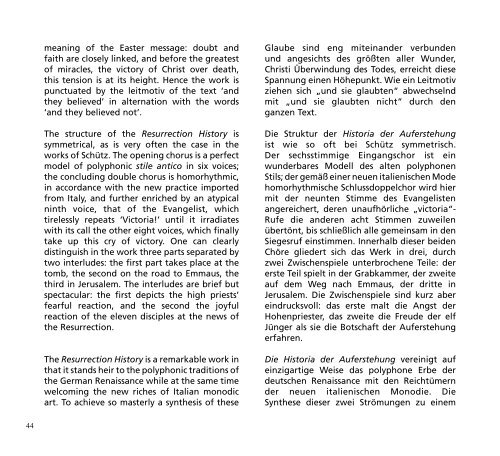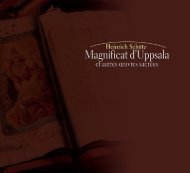Histoire de la Résurrection & Musikalische Exequien - La Chapelle ...
Histoire de la Résurrection & Musikalische Exequien - La Chapelle ...
Histoire de la Résurrection & Musikalische Exequien - La Chapelle ...
Create successful ePaper yourself
Turn your PDF publications into a flip-book with our unique Google optimized e-Paper software.
44<br />
meaning of the Easter message: doubt and<br />
faith are closely linked, and before the greatest<br />
of miracles, the victory of Christ over <strong>de</strong>ath,<br />
this tension is at its height. Hence the work is<br />
punctuated by the leitmotiv of the text ‘and<br />
they believed’ in alternation with the words<br />
‘and they believed not’.<br />
The structure of the Resurrection History is<br />
symmetrical, as is very often the case in the<br />
works of Schütz. The opening chorus is a perfect<br />
mo<strong>de</strong>l of polyphonic stile antico in six voices;<br />
the concluding double chorus is homorhythmic,<br />
in accordance with the new practice imported<br />
from Italy, and further enriched by an atypical<br />
ninth voice, that of the Evangelist, which<br />
tirelessly repeats ‘Victoria!’ until it irradiates<br />
with its call the other eight voices, which finally<br />
take up this cry of victory. One can clearly<br />
distinguish in the work three parts separated by<br />
two interlu<strong>de</strong>s: the first part takes p<strong>la</strong>ce at the<br />
tomb, the second on the road to Emmaus, the<br />
third in Jerusalem. The interlu<strong>de</strong>s are brief but<br />
spectacu<strong>la</strong>r: the first <strong>de</strong>picts the high priests’<br />
fearful reaction, and the second the joyful<br />
reaction of the eleven disciples at the news of<br />
the Resurrection.<br />
The Resurrection History is a remarkable work in<br />
that it stands heir to the polyphonic traditions of<br />
the German Renaissance while at the same time<br />
welcoming the new riches of Italian monodic<br />
art. To achieve so masterly a synthesis of these<br />
G<strong>la</strong>ube sind eng miteinan<strong>de</strong>r verbun<strong>de</strong>n<br />
und angesichts <strong>de</strong>s größten aller Wun<strong>de</strong>r,<br />
Christi Überwindung <strong>de</strong>s To<strong>de</strong>s, erreicht diese<br />
Spannung einen Höhepunkt. Wie ein Leitmotiv<br />
ziehen sich „und sie g<strong>la</strong>ubten“ abwechselnd<br />
mit „und sie g<strong>la</strong>ubten nicht“ durch <strong>de</strong>n<br />
ganzen Text.<br />
Die Struktur <strong>de</strong>r Historia <strong>de</strong>r Auferstehung<br />
ist wie so oft bei Schütz symmetrisch.<br />
Der sechsstimmige Eingangschor ist ein<br />
wun<strong>de</strong>rbares Mo<strong>de</strong>ll <strong>de</strong>s alten polyphonen<br />
Stils; <strong>de</strong>r gemäß einer neuen italienischen Mo<strong>de</strong><br />
homorhythmische Schlussdoppelchor wird hier<br />
mit <strong>de</strong>r neunten Stimme <strong>de</strong>s Evangelisten<br />
angereichert, <strong>de</strong>ren unaufhörliche „victoria“-<br />
Rufe die an<strong>de</strong>ren acht Stimmen zuweilen<br />
übertönt, bis schließlich alle gemeinsam in <strong>de</strong>n<br />
Siegesruf einstimmen. Innerhalb dieser bei<strong>de</strong>n<br />
Chöre glie<strong>de</strong>rt sich das Werk in drei, durch<br />
zwei Zwischenspiele unterbrochene Teile: <strong>de</strong>r<br />
erste Teil spielt in <strong>de</strong>r Grabkammer, <strong>de</strong>r zweite<br />
auf <strong>de</strong>m Weg nach Emmaus, <strong>de</strong>r dritte in<br />
Jerusalem. Die Zwischenspiele sind kurz aber<br />
eindrucksvoll: das erste malt die Angst <strong>de</strong>r<br />
Hohenpriester, das zweite die Freu<strong>de</strong> <strong>de</strong>r elf<br />
Jünger als sie die Botschaft <strong>de</strong>r Auferstehung<br />
erfahren.<br />
Die Historia <strong>de</strong>r Auferstehung vereinigt auf<br />
einzigartige Weise das polyphone Erbe <strong>de</strong>r<br />
<strong>de</strong>utschen Renaissance mit <strong>de</strong>n Reichtümern<br />
<strong>de</strong>r neuen italienischen Monodie. Die<br />
Synthese dieser zwei Strömungen zu einem



